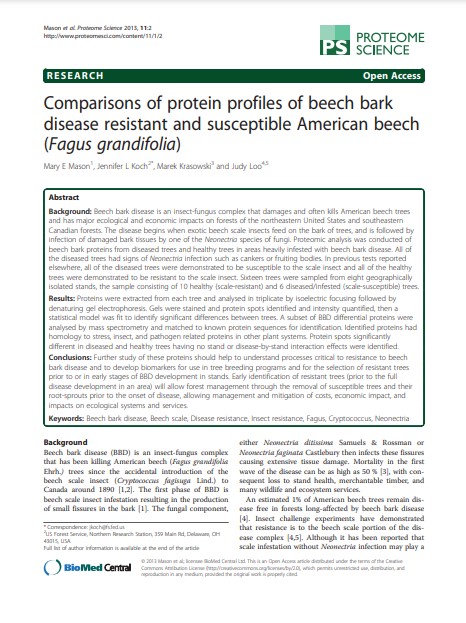Comparisons of protein profiles of beech bark disease resistant and susceptible American beech (Fagus grandifolia)
Bosque Modelo:
Fundy
Temática:
Gestión forestal
Tipo de documento:
Artículo científico
Resumen
Background: Beech bark disease is an insect-fungus complex that damages and often kills American beech trees and has major ecological and economic impacts on forests of the northeastern United States and southeastern Canadian forests. The disease begins when exotic beech scale insects feed on the bark of trees, and is followed by infection of damaged bark tissues by one of the Neonectria species of fungi. Proteomic analysis was conducted of beech bark proteins from diseased trees and healthy trees in areas heavily infested with beech bark disease. All of the diseased trees had signs of Neonectria infection such as cankers or fruiting bodies. In previous tests reported elsewhere, all of the diseased trees were demonstrated to be susceptible to the scale insect and all of the healthy trees were demonstrated to be resistant to the scale insect. Sixteen trees were sampled from eight geographically isolated stands, the sample consisting of 10 healthy (scale-resistant) and 6 diseased/infested (scale-susceptible) trees.
Results: Proteins were extracted from each tree and analysed in triplicate by isoelectric focusing followed by denaturing gel electrophoresis. Gels were stained and protein spots identified and intensity quantified, then a statistical model was fit to identify significant differences between trees. A subset of BBD differential proteins were analysed by mass spectrometry and matched to known protein sequences for identification. Identified proteins had homology to stress, insect, and pathogen related proteins in other plant systems. Protein spots significantly different in diseased and healthy trees having no stand or disease-by-stand interaction effects were identified.
Conclusions: Further study of these proteins should help to understand processes critical to resistance to beech bark disease and to develop biomarkers for use in tree breeding programs and for the selection of resistant trees prior to or in early stages of BBD development in stands. Early identification of resistant trees (prior to the full disease development in an area) will allow forest management through the removal of susceptible trees and their root-sprouts prior to the onset of disease, allowing management and mitigation of costs, economic impact, and impacts on ecological systems and services.
Información Bibliográfica
Autor:
Mason, Mary E.; Koch, Jennifer L.; Krasowski, Marek; Loo, Judy
Revista:
PROTEOME SCIENCE
Año:
2013
N°:
2
País :
Canadá
Páginas:
-
Volumen:
11
Idioma:
Ingles
Palabras claves
Beech bark disease, Beech scale, Disease resistance, Insect resistance, Fagus, Cryptococcus, Neonectria





